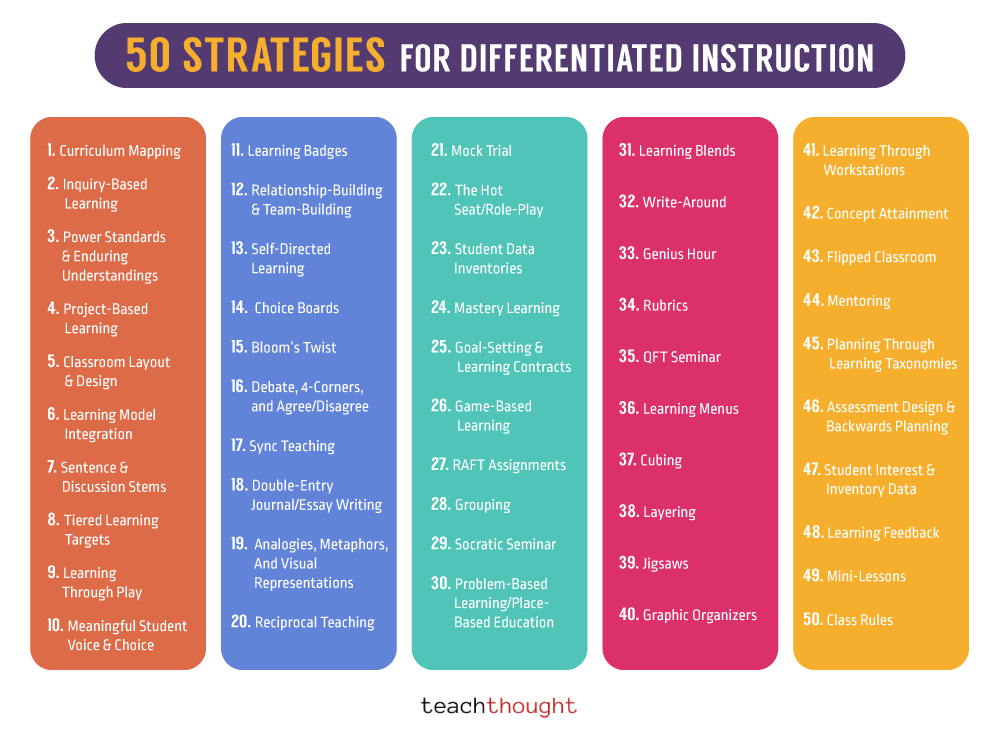
Ways To Use Strategies For Differentiated Instruction In Your Classroom
by Terry Heick
Differentiation is a simple idea that’s less simple to actuate.
Differentiation is a rational approach to meeting the needs of individual learners, but actually making it possible on a daily basis in the classroom can be a challenge.
In ‘What Differentiation Is–And Is Not: The Definition Of Differentiation,’ we offered Carol Ann Tomlinson’s overview of differentiation as ‘adapting content, process, or product according to a specific student’s readiness, interest, and learning profile.’
And in ‘Understanding Differentiation,’ clarified the goal of differentiation in learning:
“The goal of a differentiated classroom is maximum student growth and individual success. As schools now exist, our goal is often to bring everyone to ‘grade level’ or to ensure that everyone masters a prescribed set of skills in a specified length of time. We then measure everyone’s progress only against a predetermined standard…(yet)classrooms typically contain some students who can demonstrate mastery of grade-level skills and material to be understood before the school year begins—or who could do so in a fraction of the time we would spend ‘teaching’ them. These learners often receive an A, but that mark is more an acknowledgment of their advanced starting point relative to grade-level expectations than a reflection of serious personal growth.”
And therein lies the need for differentiation. What can be differentiated?
How Can You Use Differentiation In Your Classroom?
Tomlinson’s above identification of ‘Content, Process, or Product’ provide a useful starting point, as she explains that a “teacher can differentiate content. Content consists of facts, concepts, generalizations or principles, attitudes, and skills related to the subject…In many instances in a differentiated classroom, essential facts, material to be understood, and skills remain constant for all learners. (Exceptions might be, for example, varying spelling lists when some students in a class spell at a 2nd-grade level while others test out at an 8th-grade level, or having some students practice multiplying by two a little longer, while some others are ready to multiply by seven.) What is most likely to change in a differentiated classroom is how students gain access to core learning.”
Below we’ve gathered a list of 50 differentiation strategies. This is the beginning of an index of similar in form and function to the TeachThought Learning Model Index. Like the Learning Model Index, this list will be updated with definitions, tools, tips, and strategies to enact the strategies, and examples of each.
For now, we’re sharing the list and the graphic and would love your questions and comments below as we proceed. Note that we’ve already listed more than 50–and there are obviously thousands more.
50 Ways To Differentiate Instruction In The Classroom
1. Curriculum Mapping
2. Inquiry-Based Learning
3. Power Standards & Enduring Understandings
4. Project-Based Learning
5. Classroom Layout & Design
6. Learning Model Integration
7. Sentence & Discussion Stems
8. Tiered Learning Targets
9. Learning Through Play
10. Meaningful Student Voice & Choice
11. Learning Badges
12. Relationship-Building & Team-Building
13. Self-Directed Learning
14. Choice Boards
15. Bloom’s Twist
16. Debate (Also, 4-Corners and Agree/Disagree can be useful here as well.)
17. Sync Teaching
18. Double-Entry Journal/Essay Writing
19. Analogies, Metaphors, And Visual Representations
20. Reciprocal Teaching
21. Mock Trial
22. The Hot Seat/Role-Play
23. Student Data Inventories
24. Mastery Learning
25. Goal-Setting & Learning Contracts
26. Game-Based Learning
27. RAFT Assignments
28. Grouping
29. Socratic Seminar
30. Problem-Based Learning/Place-Based Education
31. Learning Blends
32. Write-Around
33. Genius Hour
34. Rubrics
35. QFT Seminar
36. Learning Menus
37. Cubing
38. Layering (e.g., layered curriculum or assessment)
39. Jigsaws
40. Graphic Organizers
41. Learning Through Workstations
42. Concept Attainment
43. Flipped Classroom
44. Mentoring
45. Planning Through Learning Taxonomies
46. Assessment Design & Backwards Planning
47. Student Interest & Inventory Data
48. Learning Feedback
49. Mini-Lessons
50. Class Rules
Bonus: Identity Charts, Time Management, Media Usage, BYOD, Classroom ‘Atmosphere,’ Scaffolded Literacy, Student-Led Conferencing, Adaptive Learning Apps, Peer-to-Peer Instruction
50 Strategies For Differentiated Instruction
